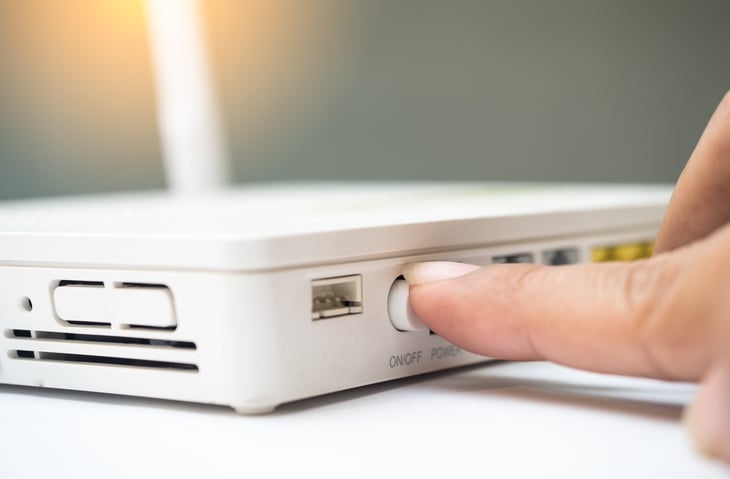
This story originally appeared on Reviews.org.
Tired of late-night emails from your internet provider warning that you’re about to go over your data cap?
You’re not alone.
In mid-2020, the average amount of data used each month was 380 gigabytes (GB), and almost 9% of internet users gobbled up more than 1 terabyte (TB) of data, according to a 2020 report by Open Vault.
Even if you find yourself using less than 1TB of data in a given month, that’s not great news. Lots of us are still working, learning and entertaining ourselves at home.
And Open Vault also found that we’re more likely to use up our internet data like it’s going out of style if we’ve got unlimited data.
Although many companies continue to offer aid during the COVID-19 pandemic, many of the unlimited data freebies offered at the beginning of the pandemic have come and gone.
So we’re all restraining ourselves from mashing “Next Episode” while watching the reboot of “Unsolved Mysteries” on Netflix.
Here is a quick look at some free (and some paid) ways to get ahead of your internet data cap.
1. Check for these heavy data users

Sometimes, the biggest chunk of your data goes toward apps and websites you don’t even know are using it.
For example, social media sites like Facebook, Instagram and Twitter may be set to autoplay and pre-load videos in your feed. That nibbles away at your data allowance, and it adds up fast.
You can save data by turning off video pre-loading and high-resolution images in apps like Instagram.
Video streaming and conferencing apps like YouTube and Zoom can also be big offenders. These apps are usually set to stream your video in the highest quality possible if you’re using Wi-Fi.
But if you’re coming close to hitting your data cap, that could quickly send you over the edge.
YouTube has a video quality setting on every video. Most video streaming apps and sites make it easy to change your video quality.
Others, like Zoom, let you uncheck the “Enable HD” setting once to make all your videos lower resolution.
However you do it, lowering your video quality to standard definition (SD, or 480p) can save you a boatload of data.
2. Plan ahead for downloads

I need to come clean: Almost all of my data overages happen because I went on a download spree. From online games to videos and images, downloads are an easy way to make your data go “poof!”
To get around this, I try to plan my downloads for the end of the month, when I know I’ll have data left over to cover my latest gaming obsession. If I’m nearing my data cap, I prioritize which games and videos I download.
If you’re a gamer, you know that online games usually come with an update patch or three. Patches may not fit into your downloading plans because they might be required to play the game.
So, make sure you prioritize patching games you want to play soon over the games that you won’t feel guilty about if they collect dust in your Steam library.
Aside from scheduling, you can also plan your downloads during “bonus” data times. A few internet providers offer extra data during odd times of the day — well, usually it’s at night.
For example, HughesNet offers 50 GB of extra data during its Bonus Zone from 2 a.m. to 8 a.m. local time.
This is the perfect opportunity to schedule a movie download to keep the kiddos entertained over the weekend or get that work PDF downloaded and saved to your laptop. Or, maybe download that Windows security update you’ve put off for far too long.
3. Watch out for automatic downloads

Speaking of downloading Windows updates: If your computer updates automatically, this could spell trouble for your data allowance.
And don’t forget that other devices around your house probably update automatically too. Ever woken up to a notification that your cellphone needs to update?
Meanwhile, your security camera instantly uploads any video footage to the cloud. All those automatic downloads may take you by surprise.
If these updates are critical, I recommend not waiting until the end of your billing cycle to download them.
Go ahead and get them taken care of right away so your data goes toward downloads that keep your devices safe and functional. But just be aware that they’re happening in the background, so you may need to hold off on other downloads later in the month.
4. Update your router’s security settings

If your data usage isn’t adding up, maybe you’re not the only one using your data. You might want to take a look at your router’s security settings.
Actually, you should update your router’s security settings anyway.
Make sure your Wi-Fi network has a strong password to keep data thieves out. Yes, a random passerby can probably guess if your Wi-Fi password is “12345.” And if they use your Wi-Fi, they also use your data.
For those of us who hand out our Wi-Fi passwords to friends and family, it may be time for a new one. Even if you trust those you’ve shared your password with, this is just good practice when it comes to keeping yourself safe online.
One other thing you should check for in your router’s settings is a Wi-Fi sharing option. This lets your modem or router create a public Wi-Fi zone that strangers can use.
This sounds awfully scary, and I don’t blame you. But ISPs that do this, like Xfinity, claim that the Wi-Fi sharing option doesn’t let others hijack your data or slow down your internet speed. If you’d rather play safe than sorry, though, turning off your Xfinity home hotspot is easy.
5. Use your phone’s data instead

Is all your internet data going down the drain? Don’t forget about your cellphone data too.
Especially if you’ve got an unlimited plan, your mobile data can help you slide into the safety of your next billing cycle if you’re nearing your data cap.
All of the big three cellphone providers — AT&T, T-Mobile and Verizon — offer unlimited plans. But it’s worth checking out smaller mobile companies too.
My mobile-savvy friends recommend Visible Wireless’s unlimited data plan. (And Visible uses Verizon’s network too.)
Quite a few internet providers are starting to offer wireless services now. And not just Verizon either. Xfinity now has Xfinity Mobile, and Spectrum internet users can get Spectrum Mobile.
More often than not, you need to already be an internet customer to sign up for these ISPs’ mobile plans. But they’ll cut you a deal and trim your cellphone bill and maybe even your internet bill if you sign up for both.
6. Upgrade to unlimited internet data

Are you a repeat offender when it comes to going over your data cap? Yup, me too. (Sorry, not sorry.) It may be more cost-effective over the long run to buy an unlimited data add-on from your ISP.
Xfinity cuts you a deal and gives you unlimited data for $11–$25 extra a month if you rent its xFi gateway. Or, you can upgrade to unlimited data and use your own equipment for an extra $30 a month.
Other internet providers, like AT&T, give you unlimited data if you bundle your internet with TV. If you’re into DIRECTV or AT&T TV NOW, what have you got to lose?
7. Swap to an internet provider with unlimited data

If your internet provider doesn’t offer unlimited data in any form or fashion, or if its data caps are low, low, low, it’s worth searching for ISPs that give you all the data you need.
Out of the biggest internet providers in the U.S., here are the ones that currently offer unlimited data with every plan (not including ISPs that offer it as an add-on):
- AT&T Fiber
- Earthlink
- Frontier FiOS
- Grande Communications
- Optimum
- RCN
- Spectrum
- Verizon Fios
- Windstream
- WOW! Internet
That’s a long list. I like that so many internet providers are all about unlimited data, but sorting through all those can be overwhelming. An easy hack is to check for internet providers using your ZIP code to see if any of these pop up.
Hopefully by now you’re armed to the teeth with easy and low-cost ways to get around your internet data cap. Because the last thing any of us needs right now is to be cut off from living our best lives online.





Add a Comment
Our Policy: We welcome relevant and respectful comments in order to foster healthy and informative discussions. All other comments may be removed. Comments with links are automatically held for moderation.